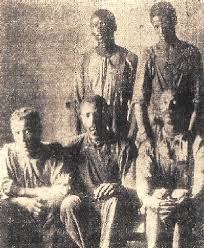Editorial: These men were innocent
Published 12:13 am Tuesday, October 17, 2017

- Lynched were Jack Dillingham, seated left; Nease Gillespie, seated right; and John Gillespie, standing right. File photo
For a century, the three black sharecroppers lynched in connection with a Rowan County family’s 1906 murder have been described as charged but never tried. Nease Gillespie, son John Gillespie and Jack Dillingham were victims, for sure, but in some people’s minds they remained murder suspects, too.
It’s time to start referring to them as innocent.
Sports journalist Bill James — the so-called “Sultan of Stats” — recently turned his mastery of numbers, analytics and logic to researching early 20th century ax murders. Combing old newspapers and records online, he and daughter Rachel McCarthy James found a 15-year trail of slayings across the country that included the deaths of Isaac and Augusta Lyerly and two of their children in Barber Junction. They share the stories in “The Man From the Train,” a book released by Scribner earlier this year.
Like scores of other victims the Jameses found, the Lyerlys were killed in their sleep, in a rural home located within walking distance of railroad tracks — in this case, the Barber Junction Depot. As in the other crimes, the killer used the blunt side of an ax he found in the yard to attack the family in the middle of the night. Then he set a bed on fire and disappeared without taking money that was left in plain view.
And like other black people who lived near ax-murder victims described in the Jameses’ book, the Gillespies and Dillingham made convenient suspects. They were sharecroppers on Isaac Lyerly’s land, and Nease and Isaac were said to have exchanged words.
In the Jim Crow era, lynching was the white South’s cruel answer to perceived insult or imagined guilt. After a crime happened, suspicions immediately turned to the nearest black person. Rumors and newspaper articles fanned the flames of racism. Black suspects were presumed guilty.
Descendants of Nease Gillespie are reacting to the Jameses’ findings with restraint. “It was rampant speculation without facts or evidence which led to the brutal murders of Nease, John and Jack,” the family said in a statement. “While the theory is intriguing, it is not evidence and we will not contribute to any narrative that does to another what was done to our family: assign blame without proof.”
Like Nease Gillespie’s family, many may not be ready to convict the man the Jameses identify, a German named Paul Mueller. Little is known about him. However, the many odd similarities between the Lyerly murder and the others described in “The Man From the Train” are known and documented. They provide strong evidence that the ax murders were committed by the same person — and that person could not possibly have been Nease Gillespie, John Gillespie and Jack Dillingham. These men should go down in Rowan County history not as merely presumed innocent because they never went to trial, but as unequivocally innocent of the Lyerly family murders — and horribly, horribly wronged.


